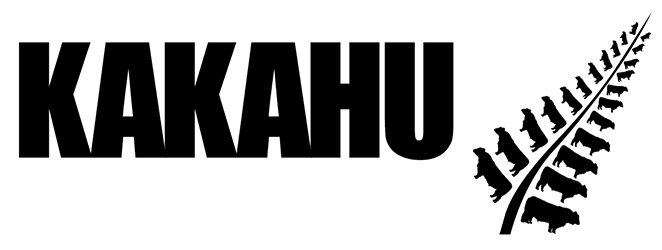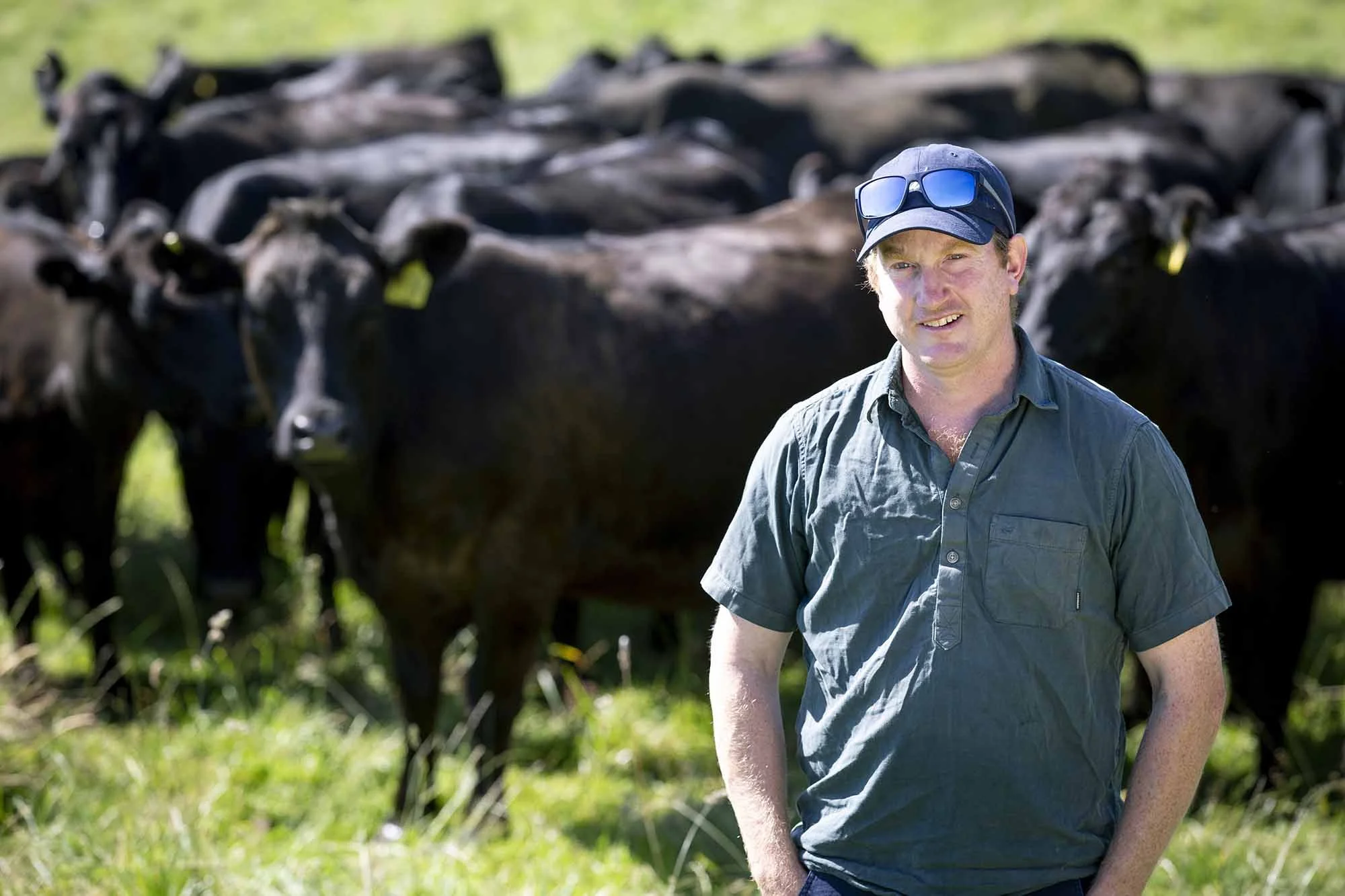Angus bring Growth and Flexibility
Words by Sandra Taylor and images by Sarah Horrocks — AngusPRO Magazine 2023
Change is a constant on Te Waimate.
While the 980ha hill country farm on the outskirts of Waimate has been home to the Studholme family for generations, it is their ability to adapt to ever-changing market demands, economic environments and weather patterns that have enabled them to remain productive and profitable.
Henry Studholme is at the helm of Te Waimate, which he farms alongside his parents Mike and Jan. Three years ago, in response to two consecutive years of extremely dry weather, the family made the decision to build more flexibility and safety valves into their farm system.
This has meant reinstating an Angus breeding cow herd, lifting ewe numbers and reducing their once-bred heifer programme.
Five years ago, the family was running a cattle to sheep ratio of 75:25 (770 cattle and 1450 Perendale ewes), the opposite of what was typical on the majority of sheep and beef properties, with a focus on Angus once-bred heifers.
More than 400 heifers were either sold prime to local trade or as a breeding proposition once they had reared a calf. The steer progeny was grown out and sold to Five Star feedlot before their second Christmas, while all heifer calves were retained for breeding. To make up numbers, replacement heifer calves were bought in.
This system meant every cattle beast on the farm needed to be growing all the time and in the case of the heifers, they needed to be able to grow themselves as well as their calves.
While this worked well for close to a decade, the two back-to-back dry years highlighted the need for more stock classes that could either be maintained, as is the case with the breeding cows, or sold.
“We couldn’t push the heifers, we needed something we could use as a tool,” says Henry.
“A couple of years of dry weather was the catalyst for that, we had nowhere to go. It was really tough as no one wanted cows and calves and we couldn’t wean the calves early. It highlighted to us that there were easier ways to do things.”
Henry built the breeding cow herd by retaining heifer calves, 50 one year and 60 the next, so he now has a young cow herd to which 10‒15 replacements are added every year.
Te Waimate is two-thirds hill country and one-third flat to rolling, of which 120ha is irrigated by k-line irrigation to augment the typical annual rainfall of 650mm.
Set up in 2004, the K-line, which draws water from the Waitaki River, suits the farm’s rolling topography and required less capital investment than other types of spray irrigation.
The hill country is deceptively steep with a mix of improved pastures and native vegetation. The cows call this country home all year round, calving on autumn-saved pasture.
Henry says the cows are very much a pasture management tool, and over winter electric fences are used to help push the cows into corners to do a thorough clean-up job, preparing pastures for lambing ewes.
A focus on growth
The Studholmes still run 130 Angus once-bred heifers and grow out steers for Five Star Beef and for this reason, breeding values for 400-day and 600-day growth rates are the main focus when selecting genetics, with a particular emphasis on 400-day growth rates.
Henry buys bulls exclusively from South Canterbury’s Kakahu stud as they offer the genetic packages he is looking for.
“Our main objective is growth because that’s what makes us money.”
Calving ease is also important, particularly for their heifer-mating programme.
“That’s why we have gone down the Kakahu route ‒ they have good growth rates and calving ease,” says Henry.
He also takes into consideration breeding values for intramuscular fat (IMF) because he believes this could be important in the future, even if they are not rewarded for it now by selling to Five Star.
“If we go out of the Five Star system the genetics will be there.”
Last year for the first time Henry grew a crop of fodder beet to grow out the steer calves. This worked extremely well, driving growth rates and allowing him to off-load the steers to Five Star in November (15 months old), a month earlier than usual at the same target weight of 450kg LW.
This allowed feed to be partitioned into other stock classes and most importantly, gave them options. Henry admits fodder beet is expensive to grow, but he had minimal animal health issues and got the growth rates he was hoping for.
Mating yearling heifers
The heifer calves are grown out on kale over winter and the majority go to the bull on November 14 weighing the mating target weight of 320kg. Only around 5% don’t reach the mating weight and these are sold as store.
Henry says they buy a yearling bull for use over the yearling heifers and this bull is then retained for use over the mixed-age cows.
After mating, the heifers are run onto the hill and stay there until July. In August they are put onto a winter feed crop and from early September they are run onto irrigated pastures and calf behind a wire.
The calving period does require some intensive management, although typically very few require assistance, thanks to a combination of genetics and management.
The heifers and calves stay on the irrigated ryegrass and clover pastures through spring and early summer and are mated there. The calves are weaned in mid-February. Henry says at that time of the year, the calves are competing with the mothers for feed as well as drawing on them for milk, hence the need to wean.
He says it takes the heifers three weeks to regain body condition post-weaning and they are then sold for breeding or prime.
“We really want to get rid of them by autumn and as most of them are in-calf, we would much rather sell them for breeding.”
Last year a buyer came in and took 100 as breeding cows and while there is not a huge market for in-calf once-bred heifers, they are proven performers of high genetic merit so are an attractive breeding proposition.
Between 10 and 15 heifers are retained as replacements for the breeding cow herd and because the breeding cow herd is so young, they cull very few ‒ hence the small number of replacements needed.
Henry says when selecting replacements they look at temperament first and then conformation. They don’t retain any animal that hasn’t reared a calf as a yearling heifer.
In the past, heifers have been given a second chance, but Henry says both research and experience have shown that this failure to get in-calf is a good indicator of future reproductive performance.
The calves from the heifers weigh 190‒200kg at weaning and spend the first year of their lives on irrigated pasture and the kale (heifers) or fodder beet (steers) feed crops.
Hill country cows
The mixed-age cows, which Henry describes as being medium-size, go to the bull in early December for calving in August. They come down off the hill for calf marking in December and weaning in late March or April, otherwise, they live on the hill country.
The calves from the mixed-age cows have an average weaning weight of 240‒250kg and join the other calves on the irrigated pasture and feed crops.
Animal health costs are kept to a minimum. The calves receive two pour-on drenches and lice treatment before winter and the R2s get a pour-on drench pre-calving.
From both a production and stock health perspective, the cattle complement the sheep operation nicely.
Changing the sheep to cattle ratio
Another significant change Henry has made is to their sheep operation. He has increased ewe numbers from 1400 to 2500 and introduced Romney genetics into their Perendale flock as he strives to lift fertility. They are lambing at 140% but Henry believes 150% is achievable.
This increase in ewe numbers and reduction in cattle numbers has shifted the cattle to sheep ratio to about 50:50 and while this has advantages by reducing feed demand, Henry admits they need to be more proactive with their pasture management.
Like the breeding cows, the ewes spend much of their time on the hill and lamb on pastures prepared by the cows.
Weaning takes place in December and Henry says as they come straight off the hill, the lambs are very much store lambs with only a small number sold prime off their mothers.
The lambs are then finished on irrigated pasture to around 18.5kg CW before the start of May. Again, the cattle complement the lamb finishing operation with the cattle cleaning up behind the lambs, which drives pasture quality and removes parasite larvae from the pasture.
The lambs are all sold to ANZCO for their antibiotic-free and grass-fed programmes.
Flexibility critical
Henry stresses that no farm policy is set in stone. He says flexibility and safety valves are critical for them and he has not discounted trading cattle or any other opportunity that might make sense from both a management and financial point of view.
But Angus genetics are likely to be central to their cattle operation for the foreseeable future. The family has a real fondness for the breed, and they grow well, they calf easily and they do a great job in both rearing a calf and maintaining pasture quality. So, like the Studholme family, Angus cattle will likely be walking Te Waimate hills for many years to come.




